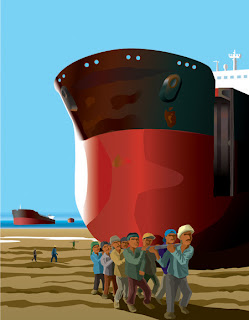
the May 2007 CURRENTS magazine.
I recently wrote of my learning to create vector illustrations, and thanks to a terrific client, I now have plenty of practice creating this type of illustration. And in creating these, the one tool I use most is the computer, and more explicitly, Adobe Illustrator and Adobe Photoshop. Of course, my language becomes explicit with these programs at times, and all the time with my computer, but software has become a vital tool to today's Illustrators and Cartoonists.
Not too long ago it was said that a Cartoonist only needed something to draw with, and something to draw on, such as a pencil and piece of paper. This is still true, today, of course, but oh, software, when working, can make life a lot easier.
Today's Important Lesson, though, is this: the computer is NOT a substitute, or replacement, for traditional skills. You need to know how to draw and paint, and most importantly, design. You need to know the rules about color, composition, balance, repetition, etc. 2-D Design and Color Theory. Computers can be fun, and the software I mentioned above can do so many things, that some people sit down, fiddle with the effects, and think they are artists. In this day and age, we still see some horrible graphic design, and bad art, because desktop publishing has made so many people mistake themselves for artists.
If you don't believe me, look at old newspapers and magazines to see what kind of illustrators and designers preceded us. Amazing work was done a century ago!
I'm a traditionalist, by nature. I still draw by hand when I can, although today I sketch more than draw. Some talented artists draw completely on the computer these days, and they do terrific stuff because they have learned to take their traditional skills all the way to the computer. Some of us have merged the two: I myself sketch until I have something good, and then scan it in and work it up in Illustrator or Photoshop, depending on the final product. Sketching is still an important part of the process, as I have mentioned before. Going with your first sketch can work, but you'll get better results by giving your ideas more time, and thought. Sitting at the computer to start work can be a mistake.
All that being said, though, software is a vital tool for today's artist. Cleaning up illustrations is so much easier in photoshop when you compare it to the razor blade and whiteout. And coloring? Forget about it! Coloring is so much easier to do on the computer, with much more reliable results. I'll admit that coloring the old fashioned way is a skill that I never fully developed. In a forthcoming book, I will show examples of my coloring from a long time ago, when Doc Martin's dyes were the tools of the day. That work hardly compares to my coloring today, which I am quite proud of.
Also, with the advent of email and PDF files, sending work to a client is as easy as pushing a button. The client no longer needs to photograph your original work, and you don't need to worry about the artwork getting there on time, or getting lost or damaged. That is, if you have original art at all.
That is one loss in these modern times. I collect original art from my favorite artists, and seeing this work is quite inspirational, and educational. You see their styles up close, can infer what tools they use, and how large they draw, and you can enjoy their work every day, looking up at your walls.
Now the next important part. Software is expensive. The two adobe products above will cost you over $1200, and after a few years, Adobe no longer supports these products if you haven't paid for expensive upgrades. Frankly, I could survive using the versions from 10 years ago. However, the new versions have some nice features, and creating PDF's directly from the program has become much easier.
SO.... if you want to be a Professional, make sure you have today's tools, as well as traditional. And it pays to take classes to use your new software. There is so much to learn that you may not get the vital stuff by practicing yourself, or reading the books. Believe me, knowing your software allows you to work quicker, and better, and that allows you to get more work done.
Have fun, but keep sketching! JOHN :0)
PS There's still time to vote for the new HappyGlyphs Logo. Please take a second to vote. :0)








3 comments:
John,
Don't forget Broadband, quite possibly the most important step forward yet for illustrators and cartoonists. On the old dial-up connections a large illustration at 300 dpi could take several hours to send out. Now it's only a matter of seconds. My telephone hasn't worked properly since going on Broadband, of course, which is a bit of a drawback, but then again I supposed I really ought to catch up with the kids round here and buy a mobile. Snds lik it mite b gr8 fuNN 2 me.
2 cul, Bri!
Yes, these days broadband does seem to have it's advantages... when it works. For some reason mine conks out whenever it starts to rain, which I just don't understand, or appreciate.
Thanks for the input! JOHN :0)
Very, very good, John!
Tahnk you
Post a Comment